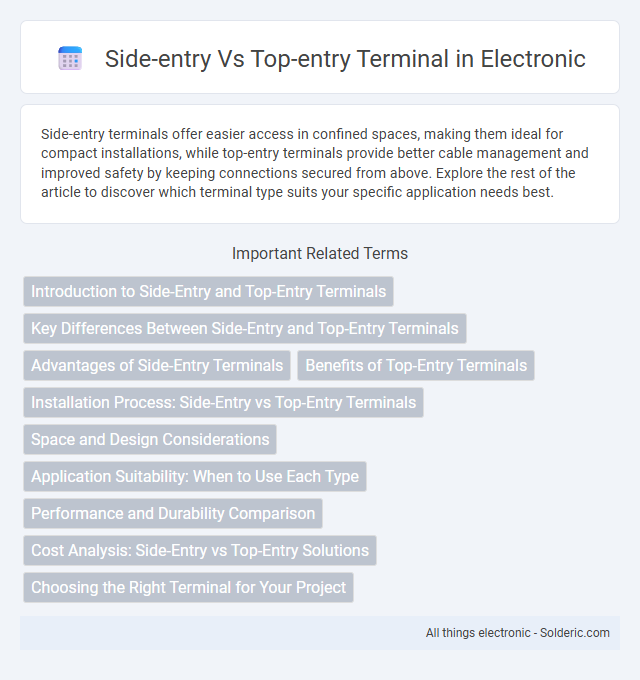Side-entry terminals offer easier access in confined spaces, making them ideal for compact installations, while top-entry terminals provide better cable management and improved safety by keeping connections secured from above. Explore the rest of the article to discover which terminal type suits your specific application needs best.
Comparison Table
| Feature | Side-entry Terminal | Top-entry Terminal |
|---|---|---|
| Design Orientation | Connection from the side | Connection from the top |
| Space Efficiency | Better for compact layouts | Requires more vertical space |
| Ease of Wiring | More accessible in tight spaces | Easier wire insertion and removal |
| Application | Widely used in space-constrained devices | Common in high-voltage and industrial terminals |
| Maintenance | Requires side access, may be challenging | Simple inspection and maintenance from above |
| Mechanical Strength | Moderate mechanical stability | Higher mechanical robustness |
| Cost | Generally lower cost | Typically higher cost |
Introduction to Side-Entry and Top-Entry Terminals
Side-entry terminals feature cable connections entering from the side of electrical devices, optimizing space in compact installations and easing cable routing. Top-entry terminals allow cables to enter from above, providing straightforward access for maintenance and reducing potential interference with adjacent components. Your choice between side-entry and top-entry terminals impacts installation flexibility, wiring convenience, and overall system design efficiency.
Key Differences Between Side-Entry and Top-Entry Terminals
Side-entry terminals feature cable connections entering from the side, ideal for confined spaces and easier access for maintenance, while top-entry terminals accept cables from above, allowing straightforward vertical routing and better protection from environmental factors. Your choice depends on installation environment constraints, with side-entry providing easier horizontal cable management and top-entry offering superior safety in wet or dusty conditions. Key differences include orientation of cable entry, ease of access during servicing, and suitability for specific spatial or environmental requirements.
Advantages of Side-Entry Terminals
Side-entry terminals offer improved protection against dust and moisture, enhancing the durability and reliability of electrical connections in harsh environments. Their compact design allows for easier installation in confined spaces and better accessibility for maintenance without disturbing adjacent wiring. Optimal for industrial applications, side-entry terminals reduce wiring complexity and improve cable management efficiency.
Benefits of Top-Entry Terminals
Top-entry terminals offer superior ease of maintenance by allowing direct vertical access to internal components without disconnecting piping or wiring, significantly reducing downtime. Their design ensures enhanced safety and reliability in high-pressure or hazardous environments by minimizing potential leak points and improving sealing integrity. You benefit from improved operational efficiency and simplified inspection processes, making top-entry terminals ideal for industries demanding stringent safety and maintenance standards.
Installation Process: Side-Entry vs Top-Entry Terminals
Side-entry terminals offer a straightforward installation process by allowing cables to enter from the side, making them ideal for tight spaces and easier cable management. Top-entry terminals require cables to be routed from above, which can demand more vertical clearance and careful alignment during installation. Your choice depends on the available space and wiring configuration, with side-entry terminals generally providing quicker and more flexible installation options.
Space and Design Considerations
Side-entry terminals offer compact installation with easier access in confined spaces, making them ideal for equipment requiring frequent maintenance. Top-entry terminals allow vertical cable routing, which enhances organization and reduces stress on connections in taller enclosures. Both designs impact overall equipment footprint and airflow, influencing cooling efficiency and layout flexibility.
Application Suitability: When to Use Each Type
Side-entry terminals are ideal for installations requiring easier cable routing and maintenance access, commonly used in low-voltage distribution panels and systems with limited vertical space. Top-entry terminals are best suited for high-voltage applications and switchgear equipment where compact design and enhanced insulation are critical, often found in industrial and utility substations. Selecting between side-entry and top-entry terminals depends on factors like available installation space, voltage level, and maintenance requirements for optimal performance and safety.
Performance and Durability Comparison
Side-entry terminals provide superior performance in environments where vibration and lateral stress are common, thanks to their robust design that ensures secure electrical connections. Top-entry terminals offer easy access for maintenance, but may be less durable under heavy mechanical strain, potentially leading to connection degradation over time. Your choice should consider the specific operational demands to maximize both performance and durability.
Cost Analysis: Side-Entry vs Top-Entry Solutions
Side-entry terminals generally offer lower installation and maintenance costs due to easier access and reduced downtime compared to top-entry solutions. Top-entry terminals may incur higher initial expenses but provide better protection against environmental factors, potentially lowering long-term repair costs. Evaluating your operational budget and maintenance priorities helps determine whether side-entry or top-entry terminals deliver the most cost-effective benefits for your facility.
Choosing the Right Terminal for Your Project
Selecting the appropriate terminal type depends on project requirements such as space constraints and ease of maintenance; side-entry terminals offer compact installation ideal for confined areas, while top-entry terminals provide straightforward access for wiring and servicing. Consider factors like electrical load capacity, environmental conditions, and safety standards to ensure optimal performance and compliance. Evaluating these parameters helps in choosing a terminal that maximizes efficiency and reliability in your specific application.
Side-entry vs Top-entry terminal Infographic

 solderic.com
solderic.com